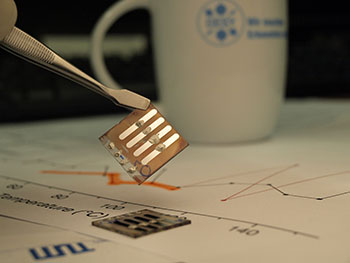
Lightweight, flexible and semi-transparent organic photovoltaics are prepared from solution and at room temperature. Credit: TU Munich
Organic photovoltaics (OPVs) are economical, flexible and versatile compared to silicon solar cells. However, OPVs are far less efficient than their established silicon counterparts. A group of researchers led by Peter Müller-Buschbaum at the Technical University of Munich (Germany) have found a way to increase OPV performance by adding magnetic nanoparticles (Adv. Energy Mater., doi: 10.1002/aenm.201401770). By adding less than one percent of these nanoparticles by weight to polymer-based OPVs, they were able to increase energy yield in a lab setting from only a few percent to 11 percent.
In an organic solar cell, sunlight creates pairs of charge carriers called excitons. Each exciton has two particles: a negatively charged electron and a positively charged “hole.” One way to increase OPV performance is to lengthen the amount of time the exciton particles are separated (i.e., increasing the exciton’s lifetime). “Extending the life of the electron-hole pair would,” according to lead author Daniel Moseguí González, “allow us to separate more of them and direct them to opposite electrodes,” thereby capturing more solar energy.
The researchers used P3HT:PCBM OPVs for their study. To increase exciton lifetime, they used relatively heavy nanoparticles made of iron oxide magnetite (Fe3O4) to flip the spin of the electron or the hole particle so that they both have spin values in the same direction. (In quantum physics, particles can have a spin value of ½ or -½. An electron-hole pair with a total spin value of 1 exists longer than a pair with a total spin of 0.)
While it’s easy to add these nanoparticles during the manufacturing process, adding too many of them increases the spacing between the light-collecting materials, which decreases OPV efficiency. Using grazing-incidence X-ray scattering, the researchers found that the ideal concentration of Fe3O4 nanoparticles by weight in P3HT:PCBM OPVs is 0.6 percent. OPV performance rapidly decays at higher concentrations of nanoparticles.
The team believes that their nanoparticle-doping method could be adapted to increase efficiency of OPVs made with different materials.
